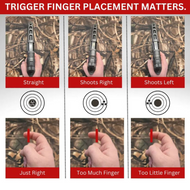Mastering Trigger Control: Tips for Better Accuracy
Apr 9th 2025
Accuracy is a crucial skill for any shooter, whether you're a seasoned marksman or a beginner just starting out. One of the most significant factors influencing accuracy is trigger control. Learning to manage the trigger correctly can mean the difference between hitting your target consistently and missing the mark. This article will guide you through the principles of mastering trigger control and provide actionable tips to improve your shooting precision.
Why Trigger Control Matters
Trigger control refers to how you manipulate the trigger of your firearm when taking a shot. Improper trigger control can cause your shots to veer off target, even if your aim is perfect. The primary goal is to press the trigger in a controlled, smooth motion without disturbing the alignment of the sights.
Key Components of Trigger Control
1. Proper Finger Placement
The placement of your finger on the trigger significantly impacts your control. Ideally:
Position the pad of your index finger (not the tip or joint) on the center of the trigger.Avoid inserting too much or too little of your finger, as this can cause the firearm to pull left or right.
2. Smooth Trigger Press
The trigger press should be a slow and deliberate motion. Avoid jerking or slapping the trigger, as this can disrupt your aim.
Instead: Apply gradual, consistent pressure straight to the rear. Focus on a surprise break, where the shot comes as a natural culmination of your press rather than an anticipated action.
3. Follow-Through
Follow-through is just as critical as the initial press.
After the shot: Maintain your grip and sight alignment. Keep the trigger pressed to the rear momentarily before releasing it forward to reset for the next shot. This ensures a smooth cycle and prevents unnecessary movement.
Common Trigger Control Mistakes
1. Anticipating the Recoil
Flinching in anticipation of the gun’s recoil is a common issue. This can cause you to push the firearm downward just before the shot. Combat this by practicing dry firing to build confidence and control without live recoil.
2. Jerking the Trigger
Jerking occurs when a shooter rapidly pulls the trigger, often in an attempt to fire quickly. This abrupt motion disrupts sight alignment. Slow down and focus on a steady press.
3. Inconsistent Pressure
Inconsistent trigger pressure can result in erratic shots. Practice applying uniform pressure throughout the trigger pull.
Practical Exercises to Improve Trigger Control
1. Dry Fire Practice
Dry firing—pulling the trigger on an unloaded firearm—is an excellent way to refine your technique.
Focus on:
Smooth trigger presses.
Maintaining sight alignment.
Observing if the sights remain steady through the pull.
2. Wall Drill
Point your unloaded firearm at a blank wall.
Focus on your front sight and practice pressing the trigger without disturbing the sight picture.
Repeat until you can consistently keep the sights steady.
3. Trigger Reset Drill
Fire a shot and hold the trigger to the rear.
Slowly release the trigger until you feel and hear the reset.
Practice firing again from the reset position to build muscle memory for controlled follow-up shots.
Mental Focus and Patience
Developing excellent trigger control requires patience and mental focus. Concentrate on the process of each shot rather than the outcome. Trust that consistency in your technique will lead to improved accuracy over time.
Conclusion
Mastering trigger control is a fundamental skill for achieving better accuracy with firearms. By focusing on proper finger placement, a smooth press, and follow-through, you can significantly enhance your shooting precision. Pair these techniques with regular practice and a commitment to improvement, and you’ll see tangible results in no time. Remember, consistency is key—the more you train, the better your trigger control will become.

